人教版小学英语四年级上册第四单元第二课时教案
- 格式:docx
- 大小:13.11 KB
- 文档页数:3
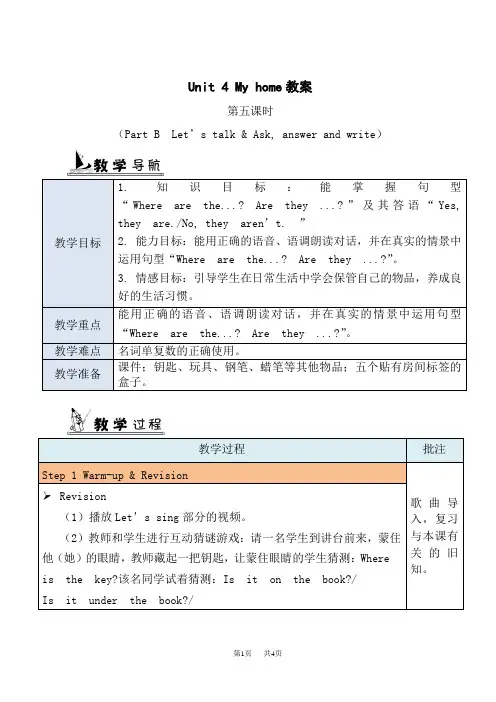
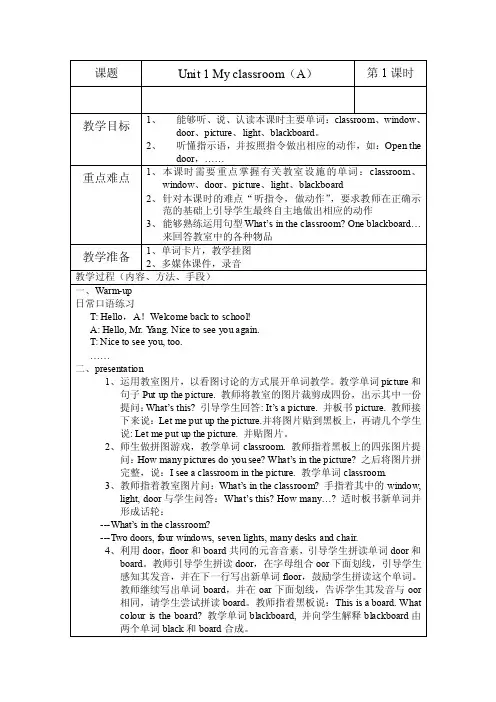

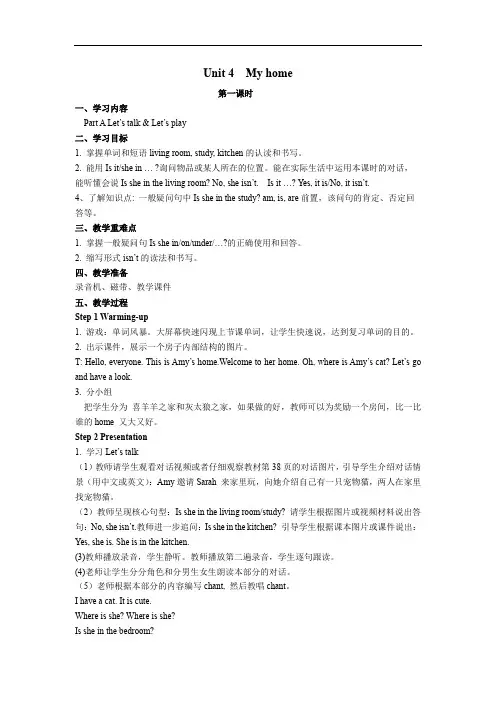
Unit 4 My home第一课时一、学习内容Part A Let’s talk & Let’s play二、学习目标1. 掌握单词和短语living room, study, kitchen的认读和书写。
2. 能用Is it/she in … ?询问物品或某人所在的位置。
能在实际生活中运用本课时的对话,能听懂会说Is she in the living room? No, she isn’t. Is it …? Yes, it is/No, it isn’t.4、了解知识点: 一般疑问句中Is she in the study? am, is, are前置,该问句的肯定、否定回答等。
三、教学重难点1. 掌握一般疑问句Is she in/on/under/…?的正确使用和回答。
2. 缩写形式isn’t的读法和书写。
四、教学准备录音机、磁带、教学课件五、教学过程Step 1 Warming-up1. 游戏:单词风暴。
大屏幕快速闪现上节课单词,让学生快速说,达到复习单词的目的。
2. 出示课件,展示一个房子内部结构的图片。
T: Hello, everyone. This is Amy’s home.Welcome to her home. Oh, where is Amy’s cat? Let’s go and have a look.3. 分小组把学生分为喜羊羊之家和灰太狼之家,如果做的好,教师可以为奖励一个房间,比一比谁的home 又大又好。
Step 2 Presentation1. 学习Let’s talk(1)教师请学生观看对话视频或者仔细观察教材第38页的对话图片,引导学生介绍对话情景(用中文或英文):Amy邀请Sarah 来家里玩,向她介绍自己有一只宠物猫,两人在家里找宠物猫。
(2)教师呈现核心句型:Is she in the living room/study? 请学生根据图片或视频材料说出答句:No, she isn’t.教师进一步追问:Is she in the kitchen? 引导学生根据课本图片或课件说出:Yes, she is. She is in the kitchen.(3)教师播放录音,学生静听。
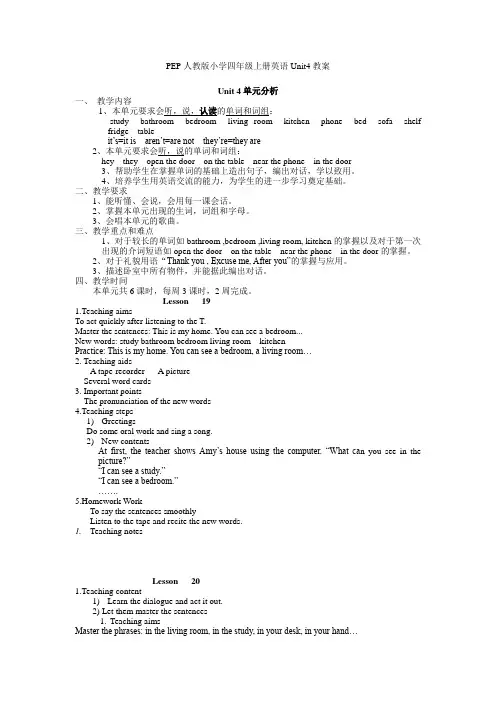
PEP人教版小学四年级上册英语Unit4教案Unit 4单元分析一、教学内容1、本单元要求会听,说,认读的单词和词组:study bathroom bedroom living room kitchen phone bed sofa shelf fridge tableit’s=it is aren’t=are not they’re=they are2、本单元要求会听,说的单词和词组:hey they open the door on the table near the phone in the door3、帮助学生在掌握单词的基础上造出句子,编出对话,学以致用。
4、培养学生用英语交流的能力,为学生的进一步学习奠定基础。
二、教学要求1、能听懂、会说,会用每一课会话。
2、掌握本单元出现的生词,词组和字母。
3、会唱本单元的歌曲。
三、教学重点和难点1、对于较长的单词如bathroom ,bedroom ,living room, kitchen的掌握以及对于第一次出现的介词短语如open the door on the table near the phone in the door的掌握。
2、对于礼貌用语“Thank you , Excuse me, After you”的掌握与应用。
3、描述卧室中所有物件,并能据此编出对话。
四、教学时间本单元共6课时,每周3课时,2周完成。
Lesson 191.Teaching aimsTo act quickly after listening to the T.Master the sentences: This is my home. Y ou can see a bedroom...New words: study bathroom bedroom living room kitchenPractice: This is my home. Y ou can see a bedroom, a living room…2. Teaching aidsA tape-recorder A pictureSeveral word cards3. Important pointsThe pronunciation of the new words4.Teaching steps1)GreetingsDo some oral work and sing a song.2)New contentsAt first, the teacher shows Amy’s house using the computer. “What ca n you see in the picture?”“I can see a study.”“I can see a bedroom.”…….5.Homework WorkTo say the sentences smoothlyListen to the tape and recite the new words.1.Teaching notesLesson 201.Teaching content1)Learn the dialogue and act it out.2) Let them master the sentences1.Teaching aimsMaster the phrases: in the living room, in the study, in your desk, in your hand…Use the dialogue smoothly.3. Important pointsThe pronunciation of the new words4.Teaching aidsA tape-recorder A pictureSeveral word cards5.Teaching steps1.GreetingSing an English song. Ask the students to introduce their homes.2.RevisionLearn the drills and practice the drills.T: What’s this? Ss: An eraser.T: yes, what does it like? S: It looks like a fish.T: Where is my eraser? Is she in the…?Ss: Y es, she is.(No, she isn’t.)Show them several pictures.T: Oh, how beautiful! Where is it?S: This is my bedroom.(This is myLiving-room. This is my bathroom.)T: Is this your ..? S: Y es, it is.(No, is n’t.)Game.-Where is my pen? -Is it in the …?- No, isn’t. - Is it in the …?-Y es, it is.Tell them the difference between “Is it…?” and “Is she…?”Listen to the tape and imitate. Practice in groups and act it out.6.HomeworkTo say the sentences smoothlyRecite the dialogue and listen to tape.2.Teaching notesLesson 211.Teaching AimsLet them master the words :home room school classroom(listening speaking reading and writing)And the sentencesWelcome to my ……home ……This is my ……room ……When they see the pictures, they can recognize and say their English names..2.Teaching Aidsa tape recorder cards pictures3.Important points4-skill words:home room school classroom4.Teaching steps1).Greeting and organizationSing an English song and do oral work.2). RevisionA:Act the dialogue of lesson 21B: Review these words:Home room school classroom3).PresentationRead the words and spell them.Ask a student come to the front to read all the words, and the others after him or her. 4).PracticeListen to the tape, imitate and practice the sentences.Read and spell the words.5. HomeworkSpell the words , then write them:Home room school classroom1.Teaching notesLesson 221.Teaching AimsLet the students master the words and phrase :phone bed shelf fridge table sofaLet the students listen and read these drill:Sit on … Make …Watch TV. Answer… Open… Set…2.Teaching Aidsa tape recorder cards pictures3.Important pointsLearn to say the words: phone shelf fridge table sofaWhen they see the subject, they can recognize and say their English names..4.Teaching steps1).Greeting and organizationSing a song and do a oral work.2). RevisionReview these words:Home room school classroom3).PresentationThe teacher shows the phone of the room and points at something one by one, and the students say it in English. In this way, learn to say the new words:phone shelf fridge table bed sofaAsk a student come to the front to read all the words, and the others read after him.4).Play a game:Passing the eight words between eight groups, and then checking which group did quickly and right.5).PracticeListen to the tape, imitate and practice the words:phone…Read and spell the words.6).Let’s doSit on the sofa. Make the bed. Watch TV. Answer the phone. Open the fridge. Set the table. 5.Homework1. Listen and read the new words and drill.2. Recite “Let’s do”.2.Teaching NotesLesson 231.Teaching content1) DrillsA: Are they on the …? A: Are they near…?B: Y es, they are. (No, they aren’t.)2)Learn the dialogue and act it out .3).Let’s chant.2. Teaching aimsLet them master the short sentences:Open the door on the table near the phoneLearn the new drills.Use the dialogue smoothly.3.important points1).The pronunciation of the new words2). A: Are they on the …? B: Y es, they are.(No, the arearen’t)4.Teaching aidsA tape-recorder A pictureSeveral word cards5.Teaching steps1).Greeting and organizationSing an English song and do oral work. Ask the students to introduce their home.2).At first, the teacher talk to the students.T: Where are the key(book…)?S: It’s on the table(in the desk, near the phone…)T: Where are the keys(books…)?S: They are on the table(in the desk, near the phone…)T: Are they on the table? S: Y es, they are.(No, they aren’t.)Then learn to say the drills. And practise the drill with the Ss. From “the T ask s, theS answers” to “the S asks, the S answers.”3) Then practise these drills smoothly.Play a game.S1:Where are the keys? S2:Are they in he …?S3: No, they aren’t. S2: Are they in the …?S3: Yes, they are.Tell them the different of “Is it…?” or“Are they…?”Listen to the recorder and imitate.Work in groups and act it out.6. HomeworkRecite the dialogue.To say the sentences smoothly3.Teaching notesLesson 241 .Teaching Aims1)Let the students master the four-skill words :Window desk door chair bed2)Let the students read these sentences:What can you see in my room? I can see…When they see the objects, they can recognize and read them and do the action about them.2 .Teaching Aidsa tape recorder.3.Difficult words and emphasis:4-skill letters and words:Window desk door chair bed4.Teaching steps1)OrganizationChant together and do a oral work.2). RevisionSpell the word: Window desk door chair bedPhrase: w_nd_w d_ _r d_sk ch___b_d3).PresentationWhen the teacher point at the subject, the students say the word and spell it. Then write these words.Read the drills smoothly:What can you see in my room?I can see…Read and choose: Listen to the T and choose A,B,C or4).Listen to the tape, imitate and read..5).GameThe teacher asks a student come to the front of the class, and tell him/her a word, then asks other students guess the word.5.HomeworkSpell and write the four-skill words :。
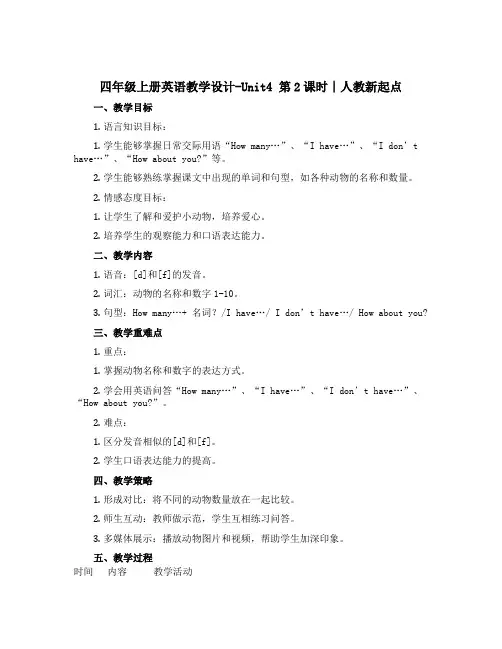
四年级上册英语教学设计-Unit4 第2课时∣人教新起点一、教学目标1.语言知识目标:1.学生能够掌握日常交际用语“How many…”、“I have…”、“I don’t have…”、“How about you?”等。
2.学生能够熟练掌握课文中出现的单词和句型,如各种动物的名称和数量。
2.情感态度目标:1.让学生了解和爱护小动物,培养爱心。
2.培养学生的观察能力和口语表达能力。
二、教学内容1.语音:[d]和[f]的发音。
2.词汇:动物的名称和数字1-10。
3.句型:How many…+ 名词?/I have…/I don’t have…/ How about you?三、教学重难点1.重点:1.掌握动物名称和数字的表达方式。
2.学会用英语问答“How many…”、“I have…”、“I don’t have…”、“How about you?”。
2.难点:1.区分发音相似的[d]和[f]。
2.学生口语表达能力的提高。
四、教学策略1.形成对比:将不同的动物数量放在一起比较。
2.师生互动:教师做示范,学生互相练习问答。
3.多媒体展示:播放动物图片和视频,帮助学生加深印象。
五、教学过程时间内容教学活动2 min热身导入1.播放歌曲“What’s this?”2. 导入本课动物主题。
10 min 拼读新单词1.教师出示单词卡片,学生跟读。
2. 学生判断[d]和[f]的发音。
15 min 认知练习1.展示不同数量的动物图片,学生用英语进行问答练习。
2.学生小组间相互练习。
10 min 单词巩固1.开展单词拼写比赛,积极参与的小组奖励点数。
2.学生复习和掌握新单词。
10 min 句型训练1.播放视频,让学生发现句型表达方式并与老师口语对练。
2.学生分组进行问答练习。
8 min教学反馈1.教师讲解疑点和难点。
2.学生进行评估。
5 min课堂小结自我总结本课的内容,展望下一节课的内容。
六、作业布置1.练习动物名称和数字的表达,写出10个学过的动物名称和数量。
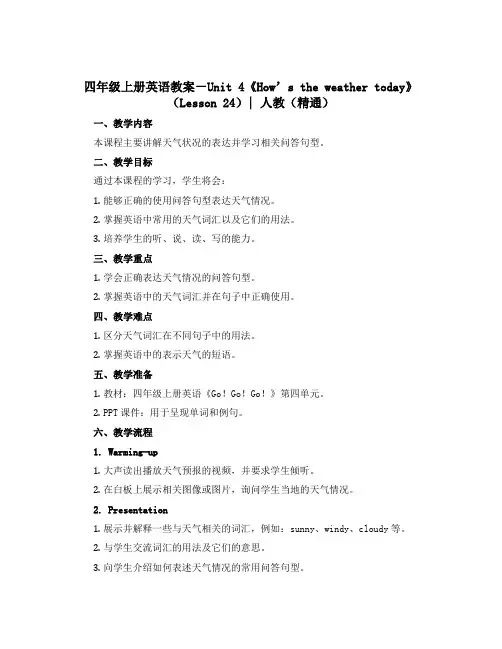
四年级上册英语教案-Unit 4《How’s the weather today》(Lesson 24)| 人教(精通)
一、教学内容
本课程主要讲解天气状况的表达并学习相关问答句型。
二、教学目标
通过本课程的学习,学生将会:
1.能够正确的使用问答句型表达天气情况。
2.掌握英语中常用的天气词汇以及它们的用法。
3.培养学生的听、说、读、写的能力。
三、教学重点
1.学会正确表达天气情况的问答句型。
2.掌握英语中的天气词汇并在句子中正确使用。
四、教学难点
1.区分天气词汇在不同句子中的用法。
2.掌握英语中的表示天气的短语。
五、教学准备
1.教材:四年级上册英语《Go!Go!Go!》第四单元。
2.PPT课件:用于呈现单词和例句。
六、教学流程
1. Warming-up
1.大声读出播放天气预报的视频,并要求学生倾听。
2.在白板上展示相关图像或图片,询问学生当地的天气情况。
2. Presentation
1.展示并解释一些与天气相关的词汇,例如:sunny、windy、cloudy等。
2.与学生交流词汇的用法及它们的意思。
3.向学生介绍如何表述天气情况的常用问答句型。
3. Practice
1.写下一些简单的问题,例如:。
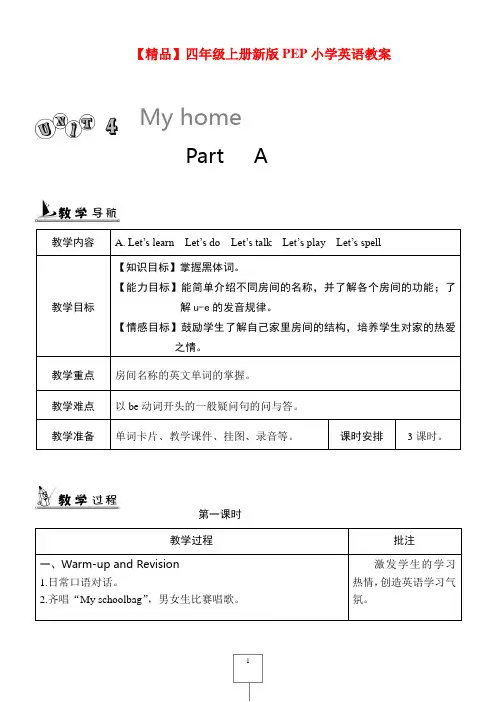
【精品】四年级上册新版PEP 小学英语教案教学内容 A. Let’s learn Let’s do Let’s talk Let’s play Let’s spell教学目标【知识目标】掌握黑体词。
【能力目标】能简单介绍不同房间的名称,并了解各个房间的功能;了解u-e的发音规律。
【情感目标】鼓励学生了解自己家里房间的结构,培养学生对家的热爱之情。
教学重点房间名称的英文单词的掌握。
教学难点以be动词开头的一般疑问句的问与答。
教学准备单词卡片、教学课件、挂图、录音等。
课时安排3课时。
第一课时教学过程批注一、Warm-up and Revision1.日常口语对话。
2.齐唱“My schoolbag”,男女生比赛唱歌。
激发学生的学习热情,创造英语学习气氛。
Part A My home第二课时第三课时二、Presentation and PracticeLet’s spell1.老师拿出一支铅笔,边做“写字”的动作边说:“We use the pencil to write.”然后再拿出自己的书本,边做“读书”的动作边说:“We use the book to read.”帮助学生明白“use”的意思。
2.老师用课件展示出几个呆萌的动物图,学生会惊叹它们的可爱。
老师说:“Yes. They are cute.”3.老师请一位学生上讲台,假装走路不小心撞到了该学生,然后老师很礼貌地对这位学生说:“Excuse me.”引出单词“excuse”。
4.板书更多u-e单词,让学生找规律。
然后老师解释u e发音,带领学生拼读。
老师请发音标准的学生带领全班朗读。
5.老师出示含“u”的单词,带领学生拼读。
让学生判断“u”的发音和“u-e”发音是否相同。
6.做游戏。
左手代表/ʌ/,右手代表/ju:/,老师读单词,学生根据读音来举左手或右手。
7.让学生找出“Listen, circle and say.”部分的单词,找得越多越好。
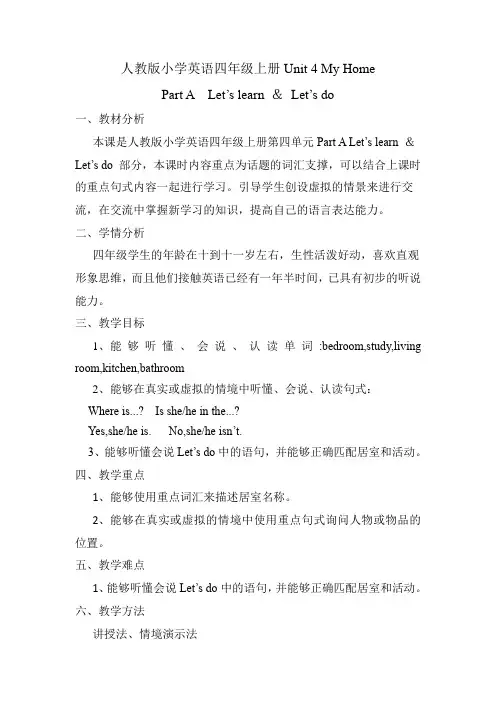
人教版小学英语四年级上册Unit 4 My HomePart A Let’s learn &Let’s do一、教材分析本课是人教版小学英语四年级上册第四单元Part A Let’s learn &Let’s do 部分,本课时内容重点为话题的词汇支撑,可以结合上课时的重点句式内容一起进行学习。
引导学生创设虚拟的情景来进行交流,在交流中掌握新学习的知识,提高自己的语言表达能力。
二、学情分析四年级学生的年龄在十到十一岁左右,生性活泼好动,喜欢直观形象思维,而且他们接触英语已经有一年半时间,已具有初步的听说能力。
三、教学目标1、能够听懂、会说、认读单词:bedroom,study,living room,kitchen,bathroom2、能够在真实或虚拟的情境中听懂、会说、认读句式:Where is...? Is she/he in the...?Yes,she/he is. No,she/he isn’t.3、能够听懂会说Let’s do中的语句,并能够正确匹配居室和活动。
四、教学重点1、能够使用重点词汇来描述居室名称。
2、能够在真实或虚拟的情境中使用重点句式询问人物或物品的位置。
五、教学难点1、能够听懂会说Let’s do中的语句,并能够正确匹配居室和活动。
六、教学方法讲授法、情境演示法七、教学准备PPT课件、视频、音频八、教学过程(一)热身导入(Warm-up)1、播放视频,熟悉、回忆有关询问物品位置的句式。
师:Before we start,let’s watch a video,just to review what we have learned.师:OK,let’s move on to today’s new lesson.【板书课题:Unit 4 My home】(二)学习新知(Presentation)1、(出示图片)介绍自己的家,让学生通过场景来理解新授单词的意思。
师:Boys and girls,where is it?师:It’s my home.Welcome to my home.I will show the rooms in my house.This is my living room.I watch TV in the living room.This is my kitchen.I have a snack.I cook delicious food in it.This is mybathroom.I take a shower,wash my face in it.This is my study.I read books in it.This is my bedroom.I have a nap and sleep in it.Do you like my home?【板书:living room,kitchen,bathroom,study,bedroom】2、学习单词:living room,kitchen,bathroom,study,bedroom3、(播放课本录音)师:You know my home well.Do you want to see Amy’s home?Let’s listen and watch.And try to answer,where is Amy’s?师:Now show me you answer.师:Where is Amy?Is she in thebedroom?(No,she isn’t.)师:Where is Amy?(She is in the study.)师:Is she in the study?(Yes,she is .)师:Where is Amy’s father?Is he in the living room?(Yes,he is)【板书:Where is...? Is she/he in the...?Yes,she/he is. No,she/he isn’t.】(再次播放课文内容,学生跟读)师:Listen to the text again and read with it.(三)课堂练习(Practice)1、(我指你说)教师指黑板上的单词,学生快速读出单词。
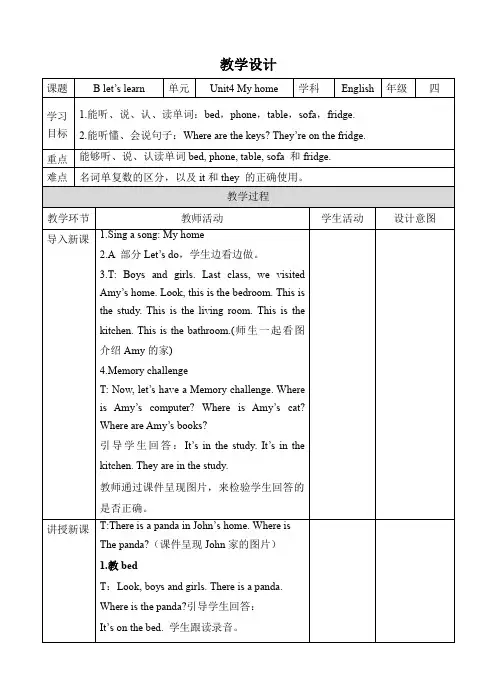
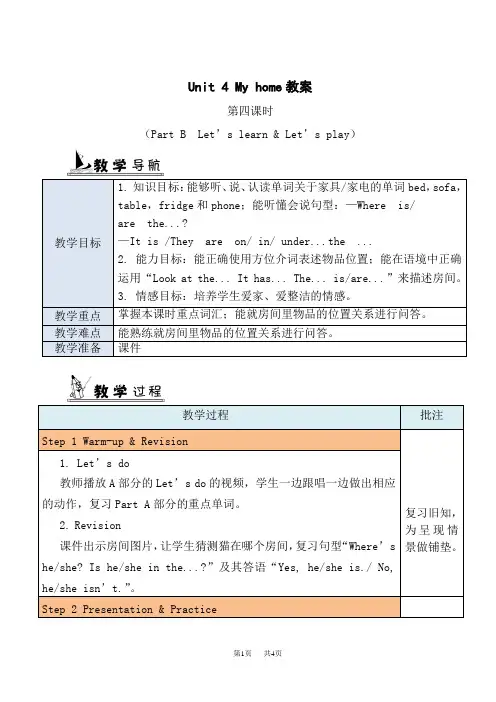
Unit4 My home单元整体分析本单元是义务教育灵通版(pep)小学英语教科书四年级上册第四单元。
单元主题为My home(我的家)。
主情景图展示了几个学生以及Zoom和Zip的家居生活,从而揭示本单元的主题:描述家里的居室及物品设施。
A部分共三页,分三课时。
第一课时为情景对话和练习部分。
Let’s talk部分Amy向Sarah介绍自己的小猫,然后两个人在家里的房间找来找去,终于找到了它。
以此介绍了询问物品或人物位置的句子:Is she in the ...? 以及表示房间名称的词汇:living room, study, kitchen。
之后的Let’s play是个猜东西位置的游戏。
以此来练习重点句式。
第二课时为词汇学习课时,Let’s learn中介绍了房间名称词汇:bedroom, study, living room, kitchen, bathroom以及询问物品或人物位置的句子:Where is ...? Is she in the ...?之后的Let’s do通过指令活动来练习房间名称以及在这个房间里能做的活动。
第三课时为语音与字母学习课时,通过读一读,听一听,唱一唱;听一听、圈一圈;听一听,圈一圈,写一写三个活动,让学生学习元音字母u在开音节中的发音/ju:/。
B部分共四页,分两课时。
第一课时仍然呈现情景对话和练习。
Let’s talk中John和妈妈到处找门钥匙,最后发现它在门上。
以此来引出询问物品和人物位置的句子Where are...? Are they ...? 以及词汇:table, phone。
之后的Ask, answer and write活动来练习重点句式与单词。
第二课时以John和Mike的对话来学习新的词汇:sofa, phone, table, fridge之后通过一个活动Let’s play来练习句子。
进一步熟悉新授词汇。
之后的读写练习、听音判断、看一看并判断的练习以及歌曲都用来巩固练习本课的重点词汇及句型,与C部分合为一个课时。
人教版英语四年级上册教案(最新7篇)因为有教育,一切才都那么美好,因为有教育,人类才有无穷的希望。
你有写过教案吗?为朋友们整理了7篇《人教版英语四年级上册教案》,如果对您有一些参考与帮助,请分享给最好的朋友。
人教版英语四年级上册教案篇一一。
教材分析:本单元内容主要围绕家庭成员展开。
通过学习,学生能介绍自己的家庭和描述自己的家庭成员等。
学习内容贴近学生的生活,教师在学习中易于创设情景,学生也会比较感兴趣。
二、单元教学目标(一)、能力目标1. 能够简单介绍自己的家庭,如:This is my uncle.2. 能够简→←单描述家庭成员,如:He’s a baseball player. He is tall and strong.3. 复习前面所学的元音字母的发音。
4. 会唱歌曲“My family”。
(二)、知识目标1.掌握单词father, mother, sister, brother, doctor, nurse, driver, farmer,能熟练听、说、读。
2.认读、理解A、B部分let’s learn 、Let’s talk中的单词和句子及Listen and chant部分的句型。
3.了解Story time等部分的内容。
(三)、情感、策略、文化等有关目标1.情感态度:培养学生热爱家庭,热爱生活的美好情感。
2.学习策略:积极运用所学英语进行表达、交流。
3.文化目标:了解英语国家中家庭成员之间的称呼习俗。
二、重点、难点重点:1.能够简单介绍自己的家庭。
2.一般疑问句的学习和简单运用。
难点:综合运用本单元的主要句型描述自己的家庭成员。
三、课时安排:六课时第一课时:A Let’s learn Let’s play第二课时:A Let’s talk Let’s count第三课时:A Let’s spell第四课时:B Let’s learn Let’s play Let’s sing第五课时:B Let’s talk Draw and say第六课时:B Read and write Let’s check C Story timeUnit 6 Meet my family第二课时A Let’s talk Let’s countLet’s count一。
四年级英语上册全册教案Unit One My classroom第一课时教学内容:A Let's learn Let's do C Let's sing教学目标:1.能听懂、会说:What's in the classroom? Aboard, two lights, many desks and chairs.并能在实际情景中运用。
2.能听、说、认读本课主要单词:classroom, window, door, picture, board, light, 3.能听懂并能按照指令做事情。
教学重点:学习What's in the classroom?及相关单词:classroom, window, door, picture, board, light。
教学难点:1.window一词注意w的发音,不要与v的发音混淆,教师在教学中应及时纠正。
2.在回答"What's in the classroom?"时,注意单词复数的读音。
教具准备:1.教材相配套的教学录音带2.教师自制的单词卡教学过程:(一)热身、复习(Warm-up / Revision)1.教师播放第一册Recycle 1单元中得"Chant and find"部分,学生跟着录音一起说。
2.教师出示与chant内容相符的图片,问:"What's in the picture?"让学生进行回答。
Picture一词由这里引出。
3.复习pencil, ruler, bag, book, pencil-case, sharpener, eraser, crayon,pen等单词。
4.引导学生用以上单词做问答练习,如:What's in the bag? What's in the pencil-case ?5.在学生回答出问题后,教师可再追问:How many pencils/pens…?使学生能用复数进行回答。
PEP人教版小学英语四年级上册Unit4单元教案Today'XXX is about our homes。
We will learn some new words and phrases to describe different rooms in a house。
Let's start with the phrase "This is my home." Repeat after me: "This is my home."Now let's learn some new words。
Look at the pictures on the wall。
This is a study。
Can you say "study"。
Good job。
Now let's say it together: "study."Next。
we have a bathroom。
Can you say "bathroom"。
Excellent。
Let's say it XXX: "bathroom."Moving on。
we have a living room。
Can you say "living room"。
Very good。
Let's say it together: "living room."Now we have a bedroom。
Can you say "bedroom"。
Great。
Let's say it together: "bedroom."Finally。
we have a kitchen。
Can you say "kitchen"。
人教版英语小学四年级上册unit4教案教案标题:Exploring Nature (探索大自然)教学目标:1. 学习并能正确使用以下词汇:tree, flower, grass, lake, mountain, river, bridge, picnic.2. 能够询问和回答有关大自然的基本问题。
3. 学习并能正确使用以下句型:What can you see? I can see...4. 培养学生对大自然的兴趣和保护自然环境的意识。
教学准备:课件、图片、课文朗读录音、实物(如花朵、树叶)、游戏道具(如河、山)。
教学步骤:Step 1: Warm-up (热身活动)1. 开始课堂,向学生展示一些与大自然相关的图片,并复习英文单词tree、flower和grass。
通过问答,让学生说出这些物体的名称并用英文描述。
2. 引导学生回忆上节课所学"Can you swim?"的问答句型,练习使用"What can you see?"的问答句型。
Step 2: Presentation (呈现)1. 向学生展示一幅关于大自然的图片,鼓励他们用英文单词描述图片中的事物。
2. 播放课文朗读录音,让学生跟读课文。
3. 引导学生回答问题"What can you see in the picture?"并给予表扬和肯定。
Step 3: Practice (练习)1. 准备实物(如花朵、树叶等),让学生观察这些实物并用英文单词进行描述。
鼓励他们在小组内进行交流,提高口语表达能力。
2. 制作一个玩具河和一座小山,让学生模拟在河边玩耍、在山上欣赏风景的场景。
教师引导学生运用"What can you see?"和"I can see..."的句型进行对话练习。
Step 4: Extension (拓展)1. 利用课件或实物展示更多与大自然相关的图片,让学生用"What can you see?"的句型表达出他们观察到的事物。
人教版小学英语四年级上册第四单元第二课时教案
教学目标
1.学习家中各个房间名称的单词以及Where is she ? Is she in the study? Yes,she is./No,she isn’t.询问“在哪里”的特殊疑问句和一般疑问句以及肯定和否定回答。
2.通过对Let’s do 的学习,让学生能听指令做动作。
3.能在真实场景中运用所学语言进行交流。
教学重难点
句型:Is it in/on/under/…? Yes, it is. No, it isn’t.
发音:it is 连读,isn’t
教具准备
1.图片study, bathroom, bedroom, living room, kitchen
2.教材相配套的教学录音带
3.多媒体课件。
教学过程
1、Preparation
1.做游戏:教师把图片study, bathroom, bedroom, living room, kitchen 放在讲台桌上,让一个学生到前面来看教师指定好的图片,然后向全班同学做出在该房间可发生的动作,让其他同学来猜一猜他看到的是哪张图片。
2.做A部分Let’s do 的游戏。
一个同学说指令,让其他同学根据指令做可能发生的动作。
(通过游戏,让学生了解不同房间的功能,并对房间名称更加印象深刻。
) (教师向学生出示study, bathroom,living room kitchen等单词的图片。
)
2、Presentation
1.教师对一个学生说:I have a new eraser. Do you have it? Where is it? 让学生回答以上问题。
教师继续对其他学生说:I have…. Do you have it? Where is it?
2.教师分别指着书、本、铅笔、尺子、橡皮等实物凭借记忆再次询问以上
学生:Is it on your desk? Is it in your pencil-box? Is it in your desk? Is it under your book? 在学生回答出Yes和No的基础上,引导他们用Yes, it is. No, it isn’t 来回答。
3.做猜一猜的游戏。
教师告诉学生有一些东西(物体或动物)分别放在家中的各个房间里。
让学生猜一猜他们到底在哪个房间中。
教师所给的单词是:desk, bed, cat, chair, TV, sofa, book, bag.
4.教师通过叙述故事,导入课文对话。
教师:一天,Sarah来到Chen Jie的家中,在Chen Jie的卧室里,看到她家的猫把她的新橡皮给叼跑了。
你知道,猫把橡皮叼到哪里去了吗?可让学生先
用句型Is it in…?来猜一猜。
让学生回答:It’s in/on/under…
Is it in your pencil-box? Is it in your desk? Is it under your book? 在学生回答出Yes和No的基础上,引导他们用Yes, it is. No, it isn’t 来回答。
5.做猜一猜的游戏。
教师告诉学生有一些东西(物体或动物)分别放在家中的各个房间里。
让学生猜一猜他们到底在哪个房间中。
教师所给的单词是:desk, bed, cat, chair, TV, sofa, book, bag.
6.教师通过叙述故事,导入课文对话。
教师:一天,Sarah来到Chen Jie的家中,在Chen Jie的卧室里,看到她家的猫把她的新橡皮给叼跑了。
你知道,猫把橡皮叼到哪里去了吗?可让学生先
用句型Is it in…?来猜一猜。
3、Practice
做Let’s play部分的游戏。
让一个人蒙上眼睛,其他的人来藏一件物品。
然后,让蒙上眼睛的同学猜
Where’s…., 蒙上眼睛的同学用Is it in/on/under/…?来猜。
其他同学用Yes, it is. No, it isn’t 来判断。
如果猜对了,换人继续游戏。
4、Production
老师准备一个包,里面放一些学生学过的实物或图片,让学生用Is it a…?de 句型,猜一猜物品的名称及其颜色、大小等。
板书设计
Is this your bedroom? Is it in/on/under……?。